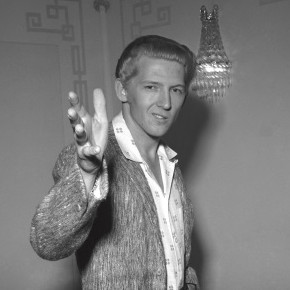“Great Balls of Fire.” The name itself conjures images of explosive energy, and the song, delivered with the raw, untamed fervor of Jerry Lee Lewis, lived up to every bit of that fiery promise. This wasn’t just a song; it was an event, a seismic shift in the landscape of rock and roll, cementing Lewis’s place as a musical force of nature. Yet, the inferno surrounding “Great Balls of Fire” wasn’t confined to the recording studio or the stage. Just as the song propelled him to unimaginable heights, the ensuing scandal threatened to extinguish his career entirely, proving that sometimes, the hottest flames burn the fastest.
 A jukebox, with the words "A History of Rock Music in 500 Songs" partially visible behind the title card.
A jukebox, with the words "A History of Rock Music in 500 Songs" partially visible behind the title card.
Before the world was set ablaze by “Great Balls of Fire,” Jerry Lee Lewis was already simmering. His previous hit, “Whole Lotta Shakin’ Goin’ On,” had announced his arrival, a potent cocktail of gospel-infused fervor and boogie-woogie piano dynamism. As Elvis Presley faced the draft, the crown of rock and roll king felt vacant, and Lewis, with his untamed stage presence and undeniable talent, was poised to seize it.
“Whole Lotta Shakin'” wasn’t just a hit; it was a phenomenon. Its success catapulted Lewis into the spotlight, landing him a performance slot in the rock and roll exploitation film Jamboree. These films, often vehicles for popular DJs like Dick Clark, were less about cinematic artistry and more about showcasing the raw energy of rock and roll’s biggest names. While the plots were often thin and predictable – think teenagers trying to put on a dance – the real draw was the musical performances. Jamboree featured a roster of artists, from the smoother sounds of Fats Domino to older generation acts like Count Basie, ensuring a broad appeal to the burgeoning youth market. Carl Perkins, another Sun Records stablemate, also appeared, further highlighting the label’s burgeoning influence.
 Jerry Lee Lewis performing with intense energy at the piano, his hair wild and his face contorted in passion.
Jerry Lee Lewis performing with intense energy at the piano, his hair wild and his face contorted in passion.
However, behind the scenes at Sun Records, tensions were brewing. Sam Phillips, the visionary behind the label, was increasingly focusing his attention and resources on Jerry Lee Lewis. For artists like Carl Perkins and Johnny Cash, this favoritism became a breaking point. Perkins, already frustrated, felt slighted by seemingly small details, like Lewis’s records being credited to “Jerry Lee Lewis and his Pumping Piano,” while his own guitar prowess went unmentioned in record credits. Promises from Phillips to rectify this felt hollow. Both Perkins and Cash, feeling undervalued, made the move to Columbia Records in November 1957, sensing their Sun contracts were nearing their end. While Cash would find even greater success at Columbia, Perkins’ star would dim somewhat, a twist of fate considering the song that would become Lewis’s biggest hit might have initially been intended for him.
According to Perkins, he was offered a choice of two songs for his Jamboree appearance, both from Hill and Range, Elvis Presley’s publishing house and also partners with Sam Phillips. Perkins reportedly dismissed both as “junk,” choosing “Glad All Over,” a song penned by Aaron Schroeder, who also contributed to Elvis’s Jailhouse Rock. However, legend – and perhaps some revisionist history – suggests one of those “junk” songs was “Great Balls of Fire.” Whether Perkins truly passed on it or not, the song landed in Jerry Lee Lewis’s lap, and both artist and producer knew instantly they had something explosive.
Sam Phillips was reportedly awestruck by Otis Blackwell’s demo of “Great Balls of Fire,” his main concern being how to even improve upon what he considered a near-perfect recording. Blackwell, a prolific songwriter who penned hits for Little Willie John (“Fever”), Frankie Valli (“You’re the Apple of My Eye”), and Elvis Presley (“Don’t Be Cruel,” “All Shook Up”), had crafted a song perfectly tailored for Lewis’s burgeoning persona. While the original demo remains elusive, Blackwell’s later recording of his own hits offers a glimpse into the raw energy that captivated Phillips.
“Great Balls of Fire” refined the formula of “Whole Lotta Shakin’,” amplifying its impact in several key ways. Where “Whole Lotta Shakin'” began with a more subdued, rolling piano intro, gradually building momentum, “Great Balls of Fire” exploded from the speakers with a dynamic, stop-start opening that immediately grabbed the listener’s attention. This intro, with its punctuated exclamations, set the stage for the song’s frenetic energy. Interestingly, this stop-start style bore a resemblance to the intro of Perkins’ signature hit, “Blue Suede Shoes,” hinting at the song’s potential suitability for him, though it’s hard to imagine Perkins imbuing it with the same unhinged intensity that Lewis brought to the track. Conversely, it’s equally difficult to picture Lewis transforming the more conventional “Glad All Over” into a worthy successor to “Whole Lotta Shakin’.”
The initial recording of “Great Balls of Fire” was rushed to meet the Jamboree film schedule, but Phillips and Lewis knew they needed a definitive version for release. They meticulously honed the song over several days, paying particular attention to the intricate timing of the stop-start intro, ensuring it sounded precise and powerful, not sloppy. Adding to the song’s unique character, the musicians on the track weren’t the usual Sun session players or Lewis’s regular band members. Instead, bassist Sidney Stokes and drummer Larry Linn were brought in, musicians Lewis claimed he never encountered again after the session, adding to the almost mythical aura surrounding the recording.
Amidst the creative fervor, a conflict arose within Lewis himself. The title, “Great Balls of Fire,” sparked a theological crisis. Was it sacrilegious? Did it align with the accusations that rock and roll was “the Devil’s music?” Lewis, deeply religious and genuinely concerned about his eternal soul, engaged in a recorded, impassioned debate with Sam Phillips. This revealing exchange showcased Lewis’s internal turmoil, his genuine belief in a literal Hell, and his fear that his music was condemning him to it. Phillips, demonstrating remarkable patience, managed to calm Lewis’s anxieties and steer him back to the music, recognizing the potential goldmine they were on the verge of unleashing.
Released with Hank Williams’ ballad “You Win Again” as the B-side, “Great Balls of Fire” was an instant supernova. It sold over a million copies within its first ten days, quickly becoming a defining anthem of 1950s rock and roll. The song transcended genres and generations, covered by artists as diverse as Dolly Parton and Aerosmith, solidifying Jerry Lee Lewis’s status as not just a star, but a rock and roll icon. Phillips and Sun Records, recognizing Lewis’s immense popularity, capitalized on his prolific output, amassing a backlog of recordings that would be released for decades, ranging from Hank Williams covers to blues numbers like “Big Legged Woman.”
 Jerry Lee Lewis performing with intense energy at the piano, his hair wild and his face contorted in passion.
Jerry Lee Lewis performing with intense energy at the piano, his hair wild and his face contorted in passion.
To maintain momentum, Sun released “Breathless,” another Otis Blackwell composition, as the follow-up single. While stylistically similar to “Great Balls of Fire,” it perhaps lacked the same explosive impact. The recording session included regular Sun drummer Jimmy Van Eaton, a disgruntled Billy Lee Riley on guitar, and Lewis’s cousin J.W. Brown on bass. To promote “Breathless,” Sam Phillips’ brother, Jud, devised an ingenious marketing scheme in collaboration with Dick Clark. Clark, host of American Bandstand and The Dick Clark Show, offered viewers a signed copy of “Breathless” in exchange for five Beechnut gum wrappers and fifty cents for postage. The promotion was wildly successful, with Sun Records overwhelmed by orders and some areas even experiencing Beechnut gum shortages. Over 38,000 singles were mailed out, further cementing Lewis’s popularity.
This period of triumph coincided with Jerry Lee Lewis joining Alan Freed’s legendary touring revue, alongside Chuck Berry, Buddy Holly, and other rock and roll luminaries. However, the tour became as infamous for the offstage clashes between Lewis and Berry as it was for the music. One source of friction was Jerry Lee’s father, Elmo Lewis, whose racist behavior led to a confrontation with Chuck Berry over parking spaces, culminating in Elmo chasing Berry with a knife, spewing racial slurs. Despite this violent outburst, the two seemingly reconciled quickly.
The other, more persistent conflict stemmed from Chuck Berry’s insistence on headlining the shows, a position Jerry Lee Lewis felt he deserved. This rivalry fueled Lewis’s onstage antics, pushing him to increasingly outrageous stunts to upstage Berry. The apocryphal tale of Lewis setting his piano on fire during “Great Balls of Fire” and then challenging Berry to top that, while likely embellished, captures the competitive and volatile atmosphere between the two rock and roll titans. Despite their feuding, Lewis held a deep respect for Berry’s songwriting, even calling him “the Hank Williams of rock and roll,” a high compliment from someone who idolized Williams. Adding another layer to their complex relationship, Lewis’s mother was a staunch Chuck Berry fan, further discouraging any open hostility towards Berry from her son.
Following the tour, Lewis recorded “High School Confidential,” the theme song for a low-budget film of the same name. Despite the film’s questionable quality, the song was a hit, climbing the charts quickly after its May 1958 release. Two days later, Jerry Lee Lewis embarked on a UK tour poised to solidify his global superstardom. But this triumphal tour would become his undoing.
Upon arriving in the UK, the press noticed the thirteen-year-old girl accompanying Lewis and his entourage. When questioned, it was revealed to be Myra Gale Brown, Lewis’s wife – and cousin. The revelation detonated like a bomb. The ensuing scandal surrounding Jerry Lee Lewis’s marriage to his young cousin is a deeply troubling and complex issue. It’s crucial to state unequivocally that this situation constituted child sexual abuse. No attempt to contextualize or explain the cultural norms of the time can excuse the inherent power imbalance and exploitation involved.
The traditional rock and roll narrative often frames the backlash against Lewis and Chuck Berry (whose own legal troubles would soon emerge) as a puritanical overreaction, an attempt by a conservative establishment to stifle the rebellious spirit of rock and roll. This narrative is a dangerous oversimplification. While societal anxieties about rock and roll certainly existed, the outrage directed at Lewis was rooted in legitimate moral concerns about the exploitation of a child. To minimize or dismiss this as mere prudery is to ignore the very real harm inflicted and to perpetuate a culture that excuses such behavior.
It’s important to acknowledge the cultural context of the American South in the 1950s, where teenage marriage, even to older men, was not uncommon, and marrying within the extended family was also prevalent. By his own standards, and within his immediate community, Lewis may not have seen his actions as inherently wrong. His first marriage occurred when he was sixteen, and his younger sister had recently married at twelve. However, cultural relativism cannot erase universal moral principles. Just as we condemn the racist practices prevalent in the South at the time, despite their cultural acceptance, we must condemn the exploitation of children, regardless of whether it was normalized within a specific community.
Even within Lewis’s own cultural context, the marriage was not universally accepted. They married in secret, and Myra’s father, J.W. Brown, Jerry Lee’s cousin and bass player, reacted with outrage, reportedly grabbing a shotgun and intending to confront Lewis, only to be dissuaded by Sam Phillips.
The UK tour, intended to last six weeks, was abruptly canceled after just three days. Lewis and his entourage returned to the US, expecting the controversy to blow over. It didn’t. Radio stations blacklisted his music, and his concert bookings evaporated. Sun Records, in a desperate attempt to salvage the situation and capitalize on the notoriety, released a novelty record, “The Return of Jerry Lee,” featuring a mock interview interspersed with clips of his songs. This ill-conceived attempt to deflect the scandal, which even included leering jokes about Myra’s youth, backfired spectacularly.
 Jerry Lee Lewis performing with intense energy at the piano, his hair wild and his face contorted in passion.
Jerry Lee Lewis performing with intense energy at the piano, his hair wild and his face contorted in passion.
The scandal effectively ended Sam Phillips’s reign as a dominant force in the music industry. With his major artists gone and Lewis’s career in ruins, Sun Records entered a period of decline. Phillips eventually sold the label to Shelby Singleton, who, to his credit, recognized the immense value of Sun’s back catalog. Singleton, along with reissue labels like Charly Records, unearthed and released a treasure trove of unreleased material from Sun’s vaults, revealing the sheer volume of incredible music recorded there during its rockabilly heyday. By the time of his death in 2003, Sam Phillips was rightfully recognized as a pivotal figure in music history.
Jerry Lee Lewis, however, faced years of struggle, playing smaller venues and slowly rebuilding his audience. By the late 1960s, he staged a remarkable comeback in country music. “Another Place, Another Time” reached number four on the country charts in 1968, launching a string of country hits that revitalized his career for the next decade.
Myra divorced Jerry Lee during this period, citing physical and emotional abuse. She remarried, becoming Myra Williams and finding success as a real estate agent. Jerry Lee Lewis continued his tumultuous life, marrying several more times. His personal life remained shrouded in controversy, marked by further marriages, allegations of violence, and erratic behavior. Even in his later years, the “Killer” remained a complex and often contradictory figure, still performing into his eighties, grappling with his legacy and his place in rock and roll history – and perhaps, his ultimate destiny. “Great Balls of Fire,” the song that propelled him to fame, remains a testament to his raw talent and untamed energy, forever intertwined with the scandal that nearly consumed him, a stark reminder of the volatile nature of fame and the enduring power of a single, explosive song.


